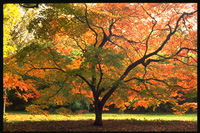Click on image for full size
NASA
Giant Crater Found on Asteroid Vesta!
News story originally written on September 9, 1997
A huge crater has been discovered on asteroid Vesta with the help of the Hubble Space Telescope. The crater is 285 miles across. This is massive when compared to the Vesta's 330 mile diameter. If Earth had a crater of proportional size, it would fill most of the Pacific Ocean basin.
Something large impacted Vesta long ago. In fact, the impact
gouged out one percent of the asteroid's initial volume. This means that over half a million cubic miles of rock were thrown out into space. About six percent of meteorites that are found on Earth have a similar composition to that of Vesta. The impact that caused the crater on Vesta may be the original source of many of these meteorites.
Scientists are excited about this discovery. "This is a unique opportunity to study the effects of a large impact
on a small object," says Michael Gaffey of Rensselaer Polytechnic
Institute, Troy, New York. "This suggests that more asteroids from the
early days of the solar system may still be intact."
You might also be interested in:

The Hubble Space Telescope (HST) was one of the most important exploration tools of the past two decades, and will continue to serve as a great resource well into the new millennium. The HST is credited
...more
It was another exciting and frustrating year for the space science program. It seemed that every step forward led to one backwards. Either way, NASA led the way to a great century of discovery. Unfortunately,
...more
The Space Shuttle Discovery lifted off from Kennedy Space Center at 2:19 p.m. EST, October 29th. The sky was clear and the weather was great as Discovery took 8 1/2 minutes to reach orbit for the Unitied
...more
A moon was discovered orbiting the asteroid, Eugenia. This is only the second time in history that a satellite has been seen circling an asteroid. A special mirror allowed scientists to find the moon
...more
Will Russia ever put the service module for the International Space Station in space? NASA officials are demanding an answer from the Russian government. The necessary service module is currently waiting
...more
During a period of about two days in early May, 1998, the ACE spacecraft was immersed in plasma associated with a coronal mass ejection (CME). The SWICS instrument on ACE, which determines unambiguously
...more
J.S. Maini of the Canadian Forest Service has referred to forests as the "heart and lungs of the world." Forests reduce soil erosion, maintain water quality, contribute to atmospheric humidity and cloud
...more















